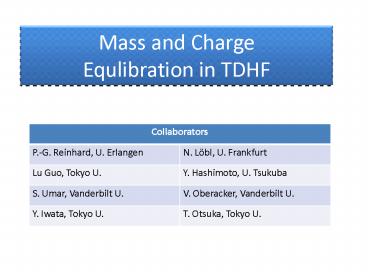Mass and Charge Equlibration in TDHF - PowerPoint PPT Presentation
1 / 35
Title:
Mass and Charge Equlibration in TDHF
Description:
... forward direction with mass. 12 A tentative explanation ... Peripheral mass exchange with forward focussing ... Total masses. s.p. wave functions. Conclusions ... – PowerPoint PPT presentation
Number of Views:24
Avg rating:3.0/5.0
Title: Mass and Charge Equlibration in TDHF
1
Mass and Charge Equlibration in TDHF
2
Some Properties of TDHF
- In Time-Dependent Hartree-Fock (since 1972) the
time-dependent mean-field equations are solved
numerically for nuclear collisions. - Because of advances in computing, TDHF is being
reconsidered by many groups worldwise as a
description of low-energy heavy-ion collisions - It is now possible to use a full Skyrme energy
functional and 3D geometry - TDHF contains only one-body dissipation and no
fluctuations semiclassical behavior - Results show surprisingly good quantitative
description of fusion without adjusted parameters - Many aspects of numerical reliability still need
to be investigated more intensively
3
- Methods
- Static and time-dependent Hartree-Fock
- Full Skyrme force
- Cartesian grid in 3D, no symmetries
- Differencing using FFT
- Exact treatment of Coulomb boundary condition
4
The Skyrme Energy Functional
Red minimum set of time-odd couplings to assure
Galilei invariance
5
Mg Pb Motivation
- Experimental data at GSI seem to hint at
transparency.S. Heinz et al., Eur. Phys. J. A
DOI 10.1140/epja/i2008-10671-9 - 25Mg206Pb near Ecm193 MeV
- Ejected fragment in the forward direction with
mass ?12 - A tentative explanation could be
- TDHF feedthrough for central collisions
- Peripheral mass exchange with forward focussing
- This led to new insights on nucleon exchange in
TDHF
6
Transparency does occur at higher energies, here
at 550 MeV
7
Central collisions
There is increasingtransparency at higher
energies. Analysis shows that 90 of the ejected
fragment wave functions are from the initial
projectile. The properties of the ejected
material are quite unusual, however.
Properties of fragment in forward direction
8
The density, however,
9
Peripheral Collisions at 350 MeV
- There is a systematic increase in transfer with
decreasing b - Proton transfer sets in much more rapidly
10
Dipole Development
b
The dipole seems to indicate rapid relaxation
with oscillations superimposed. Unfortunately
it contains a strong distance dependence and
local internal GDRs of the fragments
total
projectile
target
11
Details at b 9.3 fm, Ecm170 MeV
12
Time-dependence of Transfer
Compound value
A
N
N/Z
Z
The proton and neutron numbers in the smaller
fragment seem to rapidly stabilize and approach
the compound value. E 350 MeV, b 9.3 fm
13
Detailed Exchange
b9.3 fm
- Transfer set in very rapidly even for peripheral
collisions - No evidence for oscillations in this regime
- Statistical mixing seems to be the mechanism
- Projectile neutron/proton transfer ratio close
to 1, but for target larger than N/Z . Reason? - Mixing of projectile target matter is very
strong - To be checked is the neck size or the
interaction time the limiting factor?
14
Target Material Development
15
Projectile Material Development
16
Density and Potential
17
Mg Wave Function 1 350 MeV 8.8 fm
18
Mg Wave Function 23 350 MeV 8.8 fm
19
Lower Energy, Light System
16O20C, 100 MeV, 5.8 fmB. SchütrumpfBachelor
Thesis
20
Total masses
s.p. wave functions
21
Conclusions
- The exchange of wave functions starts extremely
rapidly - The process of mixing appears to be statistic no
evidence for oscillations - The single-particle dissipation mechanism
appears to be very effective no need for
NN-collisions in the early stage of the collision - Transparency for central collisions may still be
unphysical special symmetry makes dissipation
slower - To understand the physics, it will be useful to
look at the details of TDHF calculations
22
Angular Momentum Not Conserved?
23
Conserved Quantities
Note that conservation is physically incorrect if
particles leave the cell but are spuriously
reentered by boundary conditions!
24
Momentum Conservation
Free translation of 16O through a numerical
mesh Kinetic energy 48 MeV/c
25
Both periodic and reflecting boundary conditions
can change the angular momentum drastically!
26
EmissionandReflectionin Log (r)
27
Rotation of a Cranked Nucleus
- Obtain the static Hartree-Fock solution with an
constraint - Use this as the starting value for a
time-dependent calculation without constraint
term - The result is a uniformly rotating nucleus in the
3-dimensional Cartesian grid - This could be useful for studying unstable
rotation
28
Rotation of Mg24, full physics, w2 MeV/hbar
29
Rotation of Mg24, full physics
30
Rotation of Mg24, full physics
The changes in angular momentum are surprisingly
small and correlated with the rotation angle. In
this case, the moment of inertia is very close to
the rigid-body value.
31
Rotation of Mg24, full physics, w2 MeV/hbar
The moments of inertia show small excitations
through the interaction with the grid, which are
not correlated simply with the orientation angle.
32
Tests and Correction Attempts
Spherical enclosing potential
Enclosing absorbing potential
Spherical cutoff in J
Doubling the mesh
33
(No Transcript)
34
Attempt to determine the correct loss
25 MeV
125 MeV
- Restricted calculation run in large box, but
sum J only over small one. Should give proper
physical loss for some time. - The initial part of the reduction of angular
momentum seems to be physical. - This amounts to 2-3 rebounds, so that fusion
studies may be correct.
35
Conclusions
- The interaction of emitted particles with the
boundary causes major problems in TDHF. - It corresponds to an additional dissipation of
collective energy. - The largest effects occur for angular momentum.
- The quality of rotation of an unexcited nucleus
in the Cartesian grid is surprisingly good and
could open new applications. - For collisions, most of the loss in angular
momentum appears to be physical in the initial
stages of the reactions. - Longer-term calculations will need larger grids
and/or absorptive layers more expense. - It remains to be seen to what extent the particle
loss is physical.































